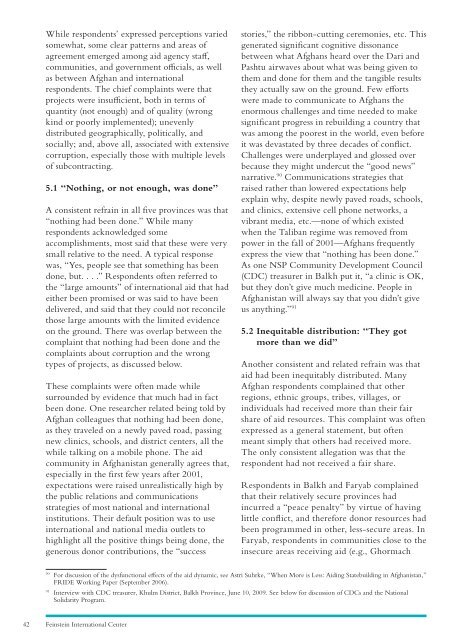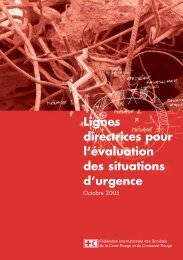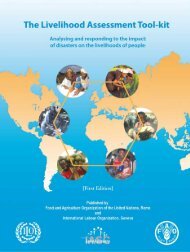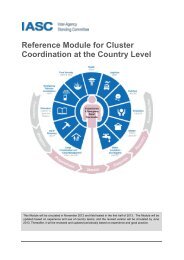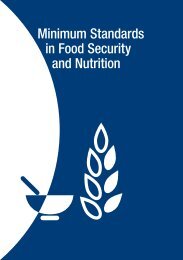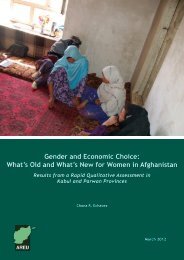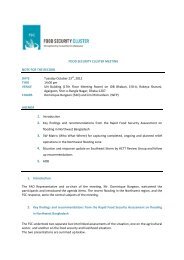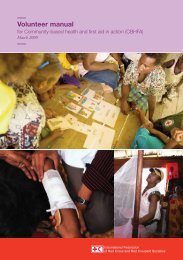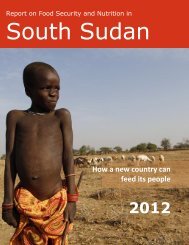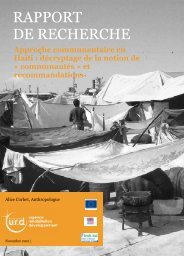Winning Hearts and Minds? - Tufts - Tufts University
Winning Hearts and Minds? - Tufts - Tufts University
Winning Hearts and Minds? - Tufts - Tufts University
You also want an ePaper? Increase the reach of your titles
YUMPU automatically turns print PDFs into web optimized ePapers that Google loves.
While respondents’ expressed perceptions variedsomewhat, some clear patterns <strong>and</strong> areas ofagreement emerged among aid agency staff,communities, <strong>and</strong> government officials, as wellas between Afghan <strong>and</strong> internationalrespondents. The chief complaints were thatprojects were insufficient, both in terms ofquantity (not enough) <strong>and</strong> of quality (wrongkind or poorly implemented); unevenlydistributed geographically, politically, <strong>and</strong>socially; <strong>and</strong>, above all, associated with extensivecorruption, especially those with multiple levelsof subcontracting.5.1 “Nothing, or not enough, was done”A consistent refrain in all five provinces was that“nothing had been done.” While manyrespondents acknowledged someaccomplishments, most said that these were verysmall relative to the need. A typical responsewas, “Yes, people see that something has beendone, but. . . .” Respondents often referred tothe “large amounts” of international aid that hadeither been promised or was said to have beendelivered, <strong>and</strong> said that they could not reconcilethose large amounts with the limited evidenceon the ground. There was overlap between thecomplaint that nothing had been done <strong>and</strong> thecomplaints about corruption <strong>and</strong> the wrongtypes of projects, as discussed below.These complaints were often made whilesurrounded by evidence that much had in factbeen done. One researcher related being told byAfghan colleagues that nothing had been done,as they traveled on a newly paved road, passingnew clinics, schools, <strong>and</strong> district centers, all thewhile talking on a mobile phone. The aidcommunity in Afghanistan generally agrees that,especially in the first few years after 2001,expectations were raised unrealistically high bythe public relations <strong>and</strong> communicationsstrategies of most national <strong>and</strong> internationalinstitutions. Their default position was to useinternational <strong>and</strong> national media outlets tohighlight all the positive things being done, thegenerous donor contributions, the “successstories,” the ribbon-cutting ceremonies, etc. Thisgenerated significant cognitive dissonancebetween what Afghans heard over the Dari <strong>and</strong>Pashtu airwaves about what was being given tothem <strong>and</strong> done for them <strong>and</strong> the tangible resultsthey actually saw on the ground. Few effortswere made to communicate to Afghans theenormous challenges <strong>and</strong> time needed to makesignificant progress in rebuilding a country thatwas among the poorest in the world, even beforeit was devastated by three decades of conflict.Challenges were underplayed <strong>and</strong> glossed overbecause they might undercut the “good news”narrative. 90 Communications strategies thatraised rather than lowered expectations helpexplain why, despite newly paved roads, schools,<strong>and</strong> clinics, extensive cell phone networks, avibrant media, etc.—none of which existedwhen the Taliban regime was removed frompower in the fall of 2001—Afghans frequentlyexpress the view that “nothing has been done.”As one NSP Community Development Council(CDC) treasurer in Balkh put it, “a clinic is OK,but they don’t give much medicine. People inAfghanistan will always say that you didn’t giveus anything.” 915.2 Inequitable distribution: “They gotmore than we did”Another consistent <strong>and</strong> related refrain was thataid had been inequitably distributed. ManyAfghan respondents complained that otherregions, ethnic groups, tribes, villages, orindividuals had received more than their fairshare of aid resources. This complaint was oftenexpressed as a general statement, but oftenmeant simply that others had received more.The only consistent allegation was that therespondent had not received a fair share.Respondents in Balkh <strong>and</strong> Faryab complainedthat their relatively secure provinces hadincurred a “peace penalty” by virtue of havinglittle conflict, <strong>and</strong> therefore donor resources hadbeen programmed in other, less-secure areas. InFaryab, respondents in communities close to theinsecure areas receiving aid (e.g., Ghormach90For discussion of the dysfunctional effects of the aid dynamic, see Astri Suhrke, “When More is Less: Aiding Statebuilding in Afghanistan,”FRIDE Working Paper (September 2006).91Interview with CDC treasurer, Khulm District, Balkh Province, June 10, 2009. See below for discussion of CDCs <strong>and</strong> the NationalSolidarity Program.42Feinstein International Center


